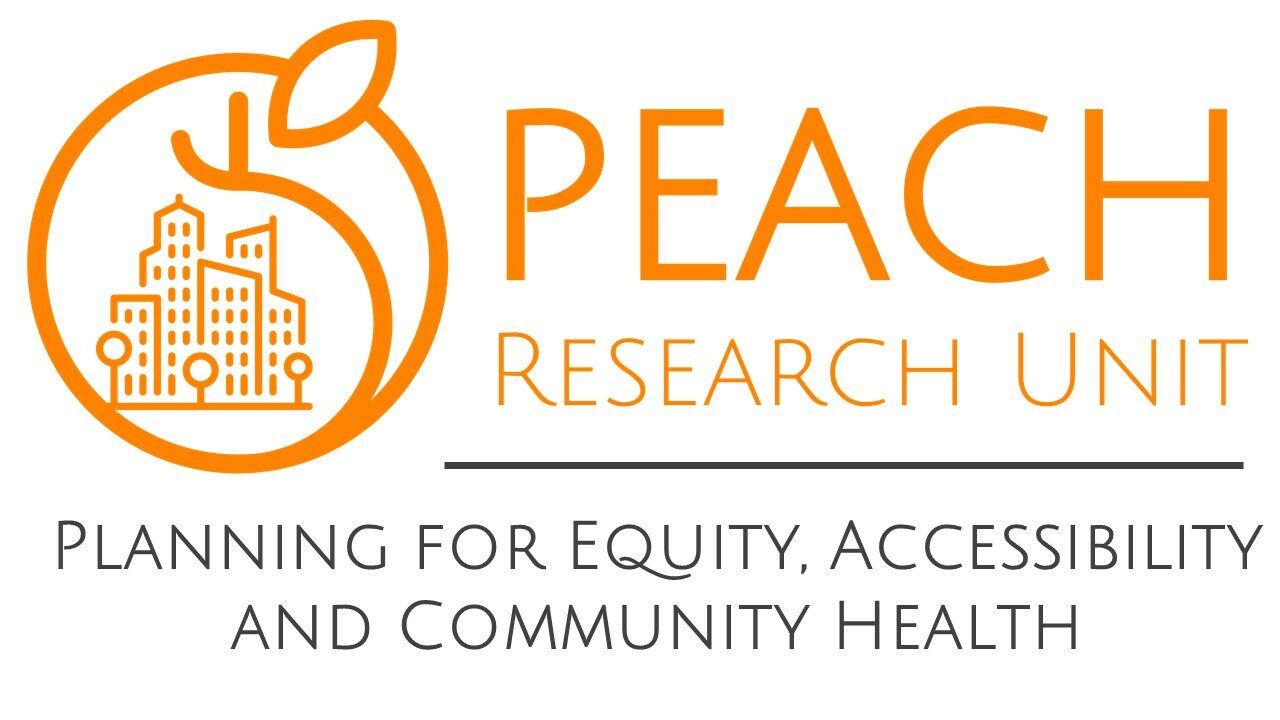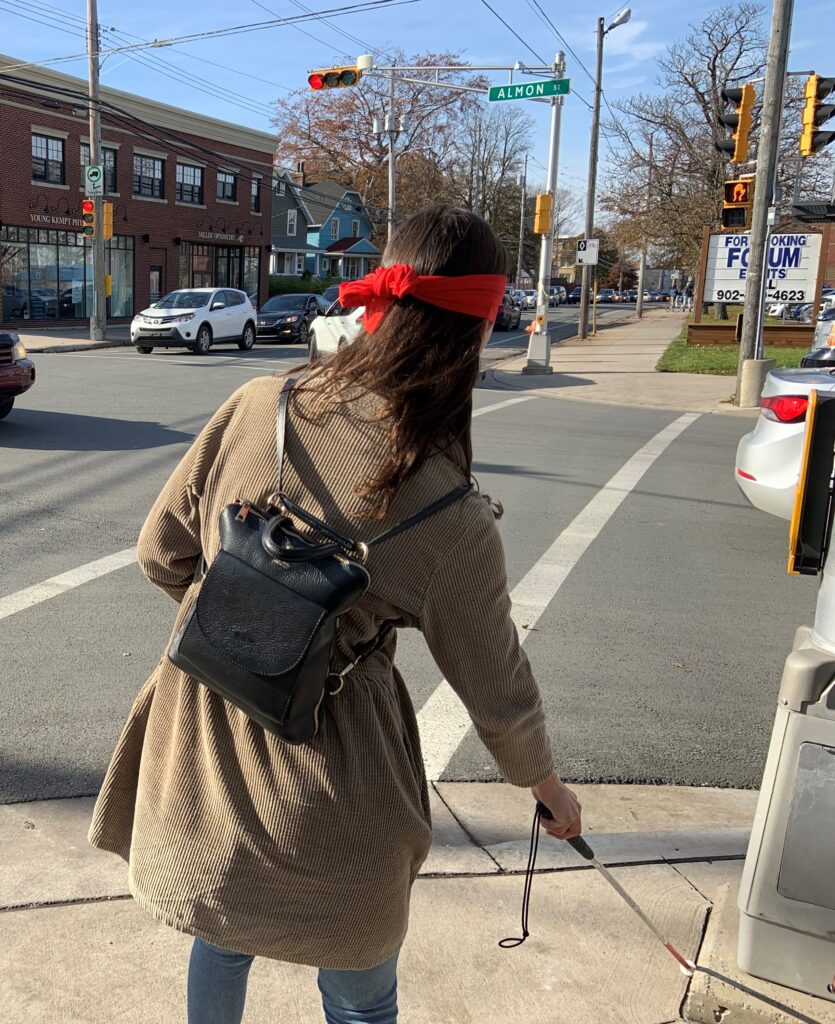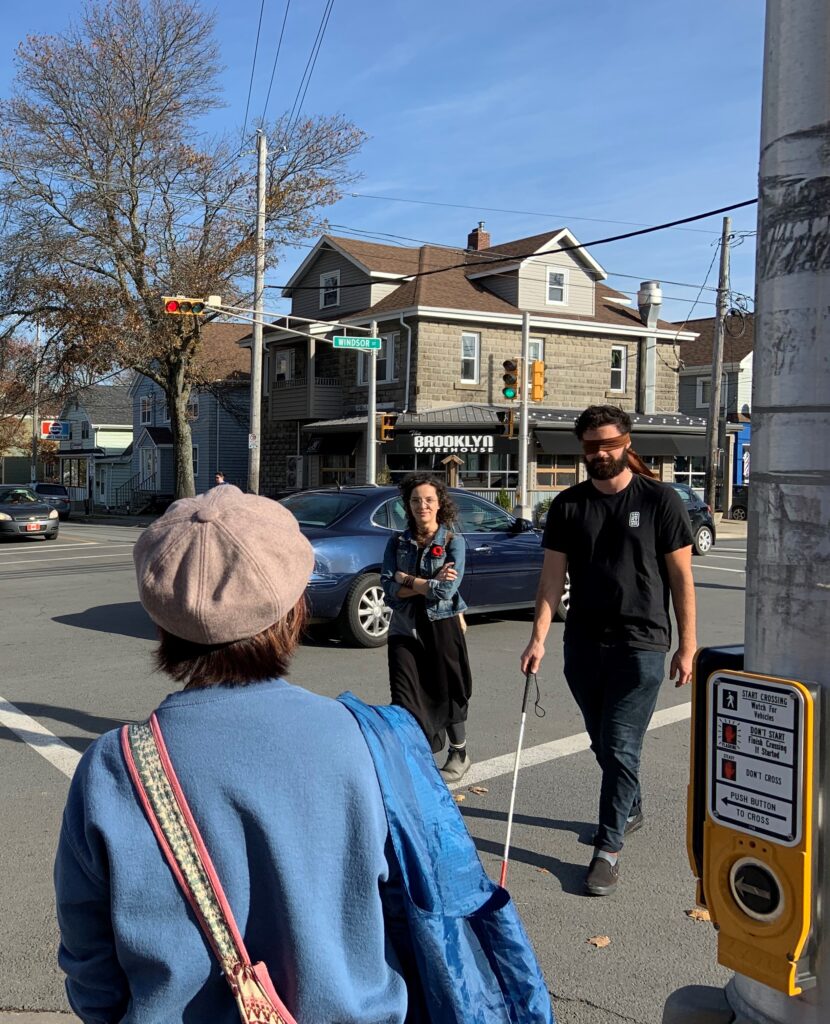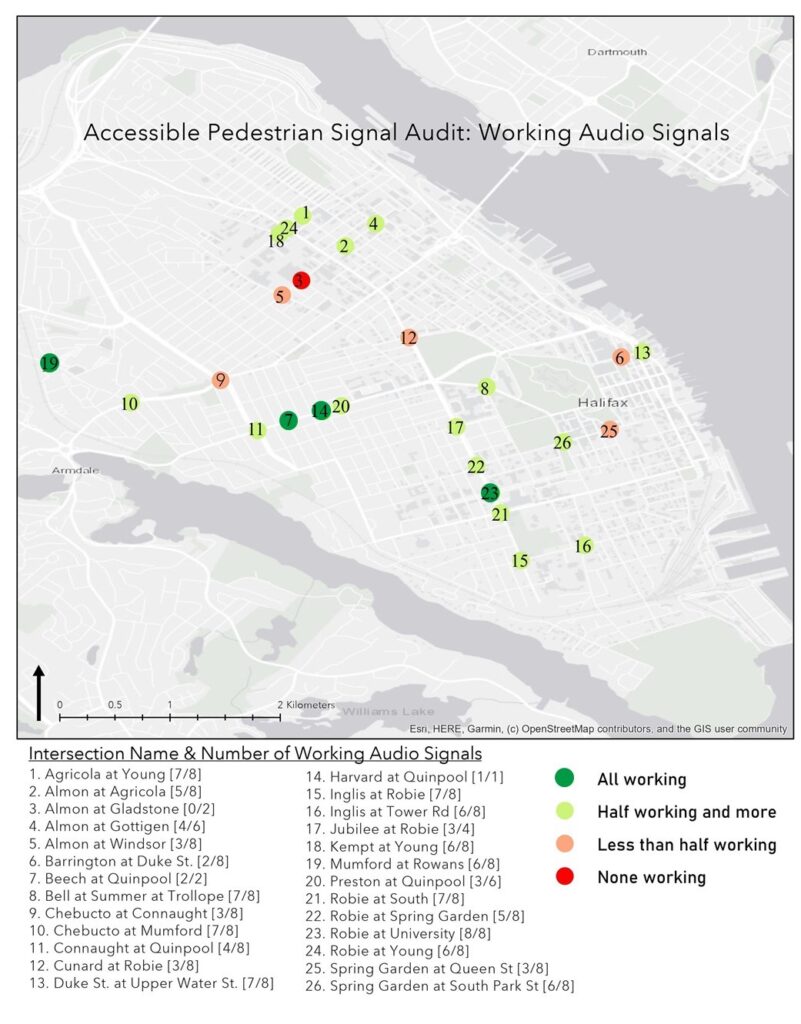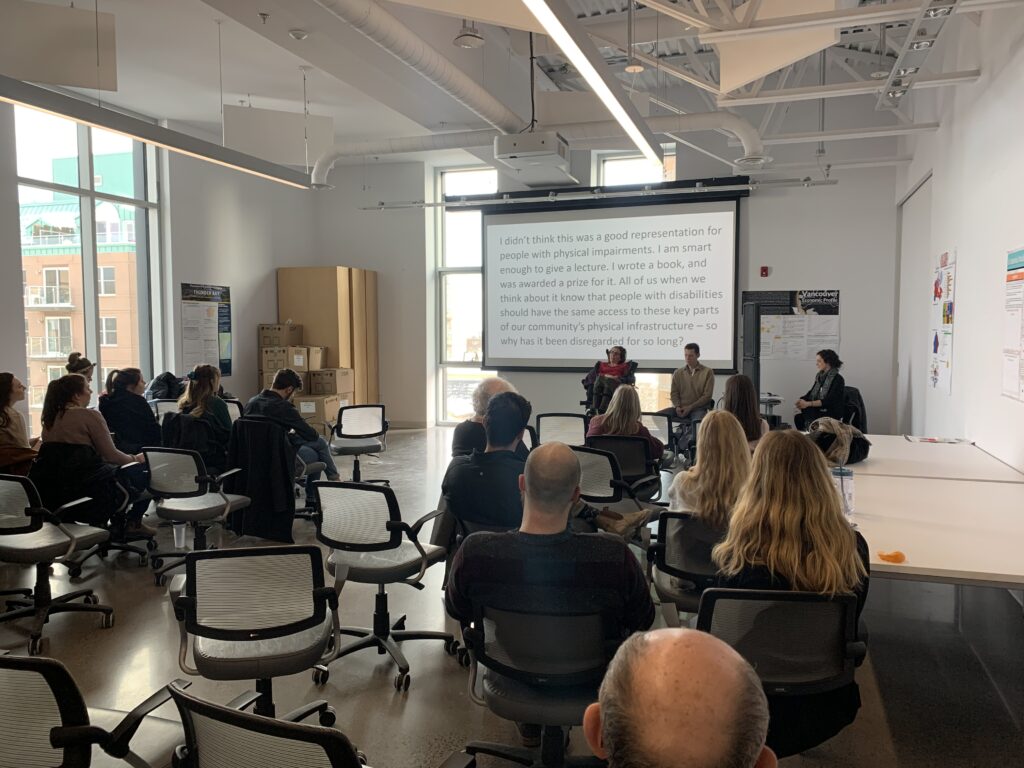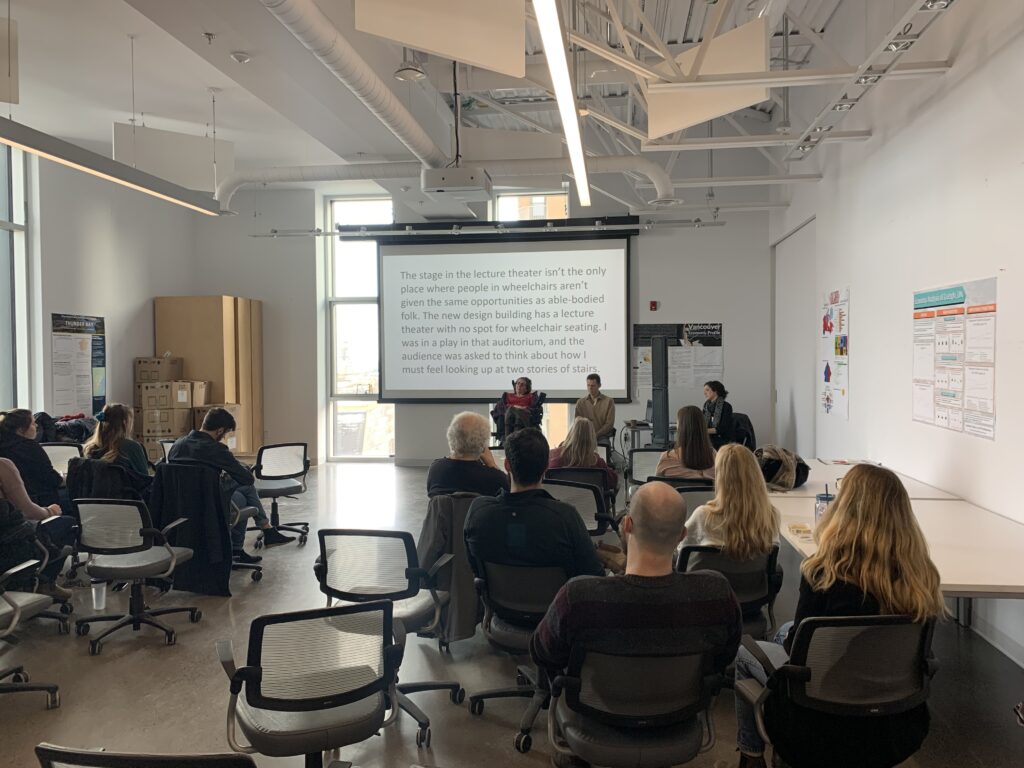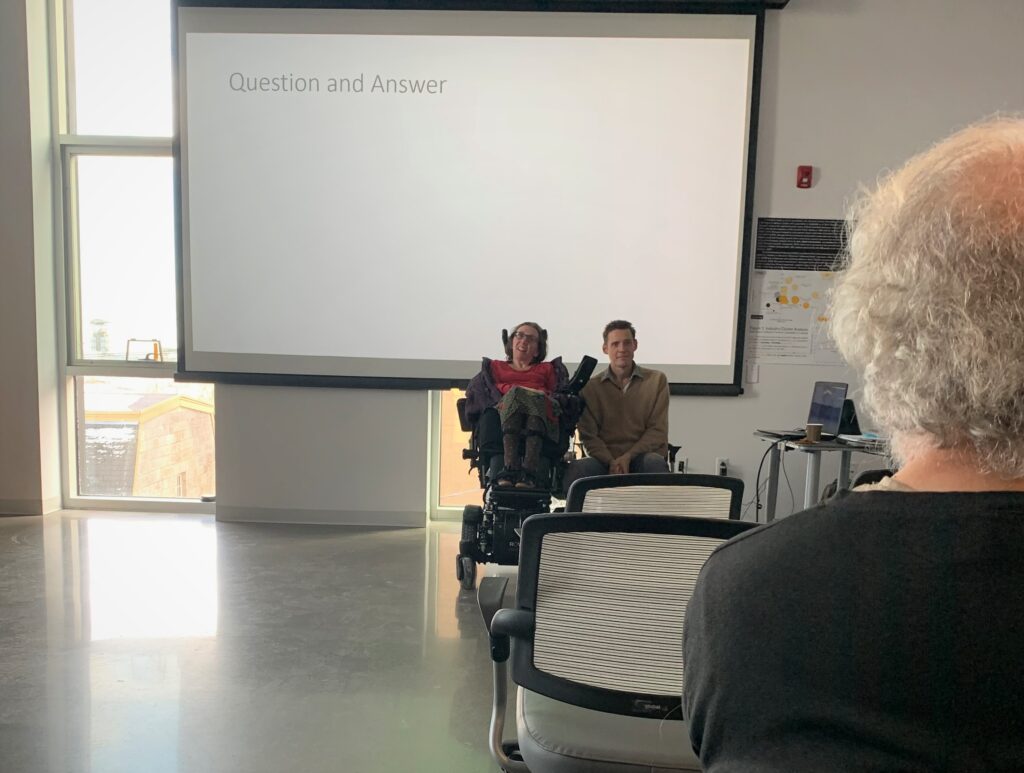PEACH at Open Street Sunday
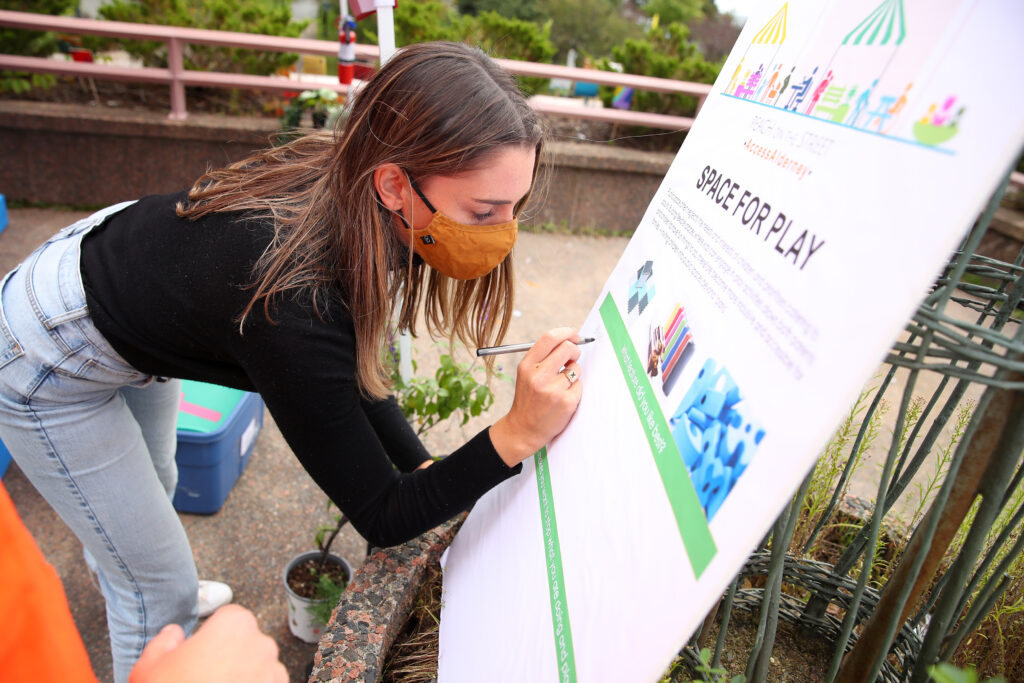
The Dalhousie PEACH Research Unit was part of Dartmouth’s Open Street Sunday, an event that opens the street up for pedestrians, cyclists, food trucks and much more! PEACH Research Unit created an accessible, inclusive and vibrant space, for kids and adults with varied abilities to enjoy. The PEACH on the Street: Access Alderney installation was located on the Alderney Plaza and contributed to PEACH’s ongoing research project; A Tactical Urbanism Approach to Assessing the Value of Public Spaces. Onsite surveys were conducted at the event to gauge public interest around accessibility and assess public opinion on the installations and accessible furnishings. Survey responses are still being collected from anyone who wants to participate, here: PEACH on the Street survey.
The event occurred on September 19th at 12pm. Despite heavy winds at times, the sun was shining and PEACH on the Street was soon crowded with hundreds of cheerful and excited community members. PEACH on the Street welcomed people of all ages, many of whom came with strollers, bikes and dogs. Dog treats and water bowls were included in the space as well as granola bars and other sweet treats which were a big hit among the kids.
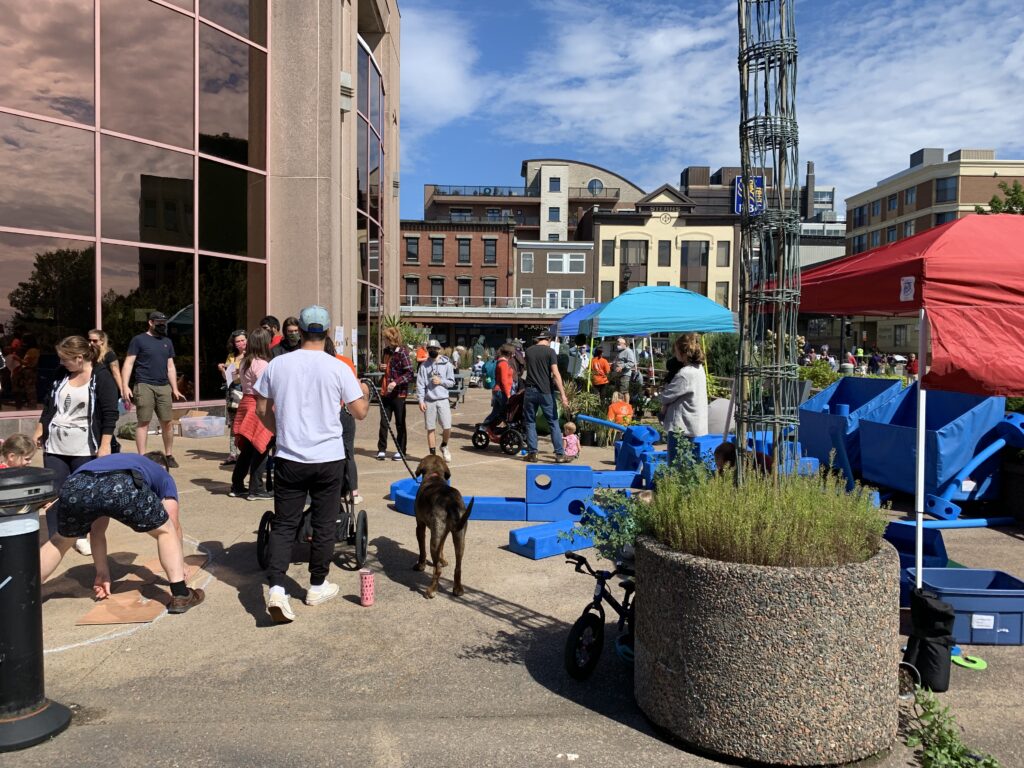
Visitors had the opportunity to learn about the importance of vibrant, inclusive spaces as well as explore the accessible installations set up by PEACH staff and volunteers. PEACH on the Street included a quiet space, giving people the opportunity to get away from the hustle and bustle of the event. The quiet space combined plants, comfy seating and lights to help people feel relaxed. Plants were a wonderful addition to the quiet space as they helped to create shade and a more enclosed feel. Many visitors also seemed to love the lounge chairs that were included in the space! PEACH on the Street also included a play space filled with toys for children. Children stayed in the play space for hours on end playing with foam blocks that were loaned from the Alderney Public Library. Accessible seating options such as a wheelchair-friendly picnic table was also found in the space, thus accommodating wheelchair users. Furthermore, clear and legible directional signages were placed along Alderney to help guide event goers in the right direction. Outdoor washrooms (porta potties) were decorated with greenery and plants to enhance the site. Many passersby mentioned how lovely the outdoor washrooms looked with the added greenery.
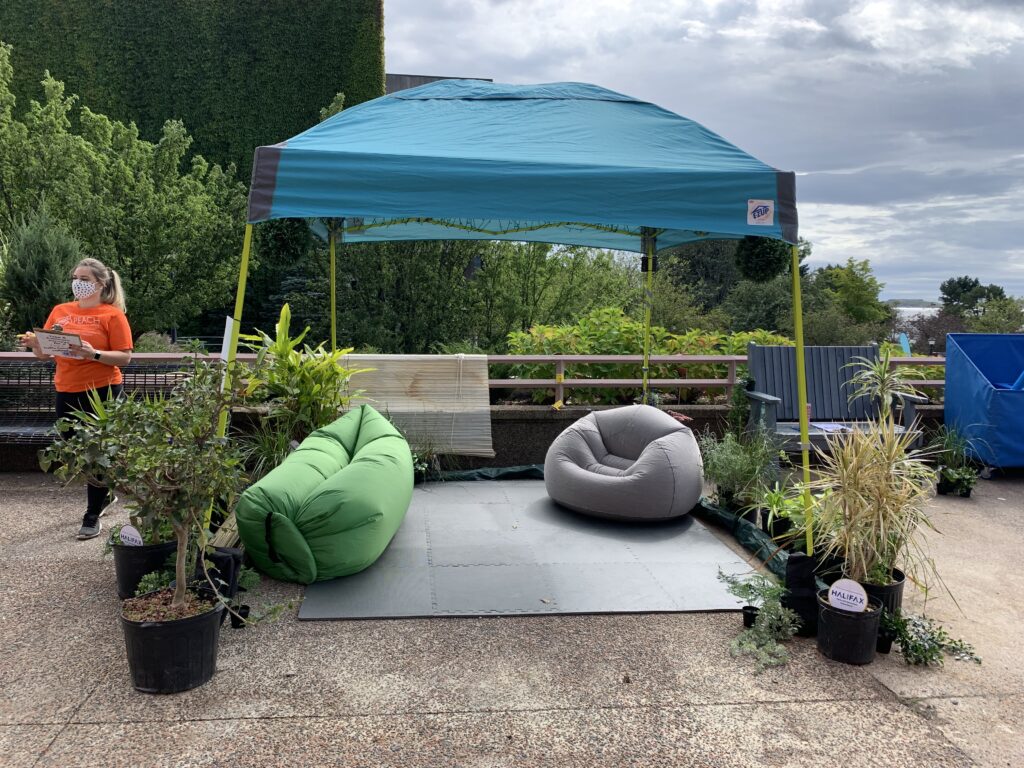
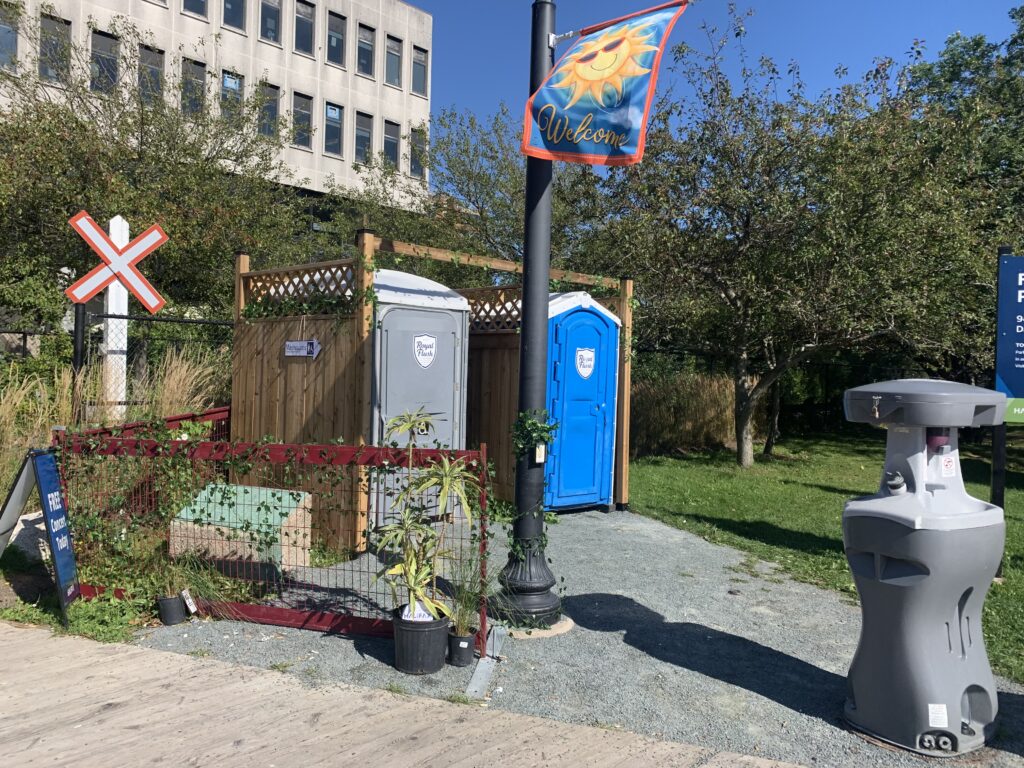
PEACH staff and volunteers worked diligently throughout the day setting up for the event and engaging with attendees. Communicating the importance of accessible, inclusive spaces with the community was a very rewarding experience! Many visitors were also curious about other PEACH projects and were excited about the strides PEACH is taking to create inclusive environments. Overall, the event was successful in engaging with fellow Haligonians, and by collecting survey data, we can demonstrate what more is needed in public spaces to improve accessibility. Working collaboratively as a team and having an excited, uplifting attitude produced a successful event and showed just how much can get done by working together!
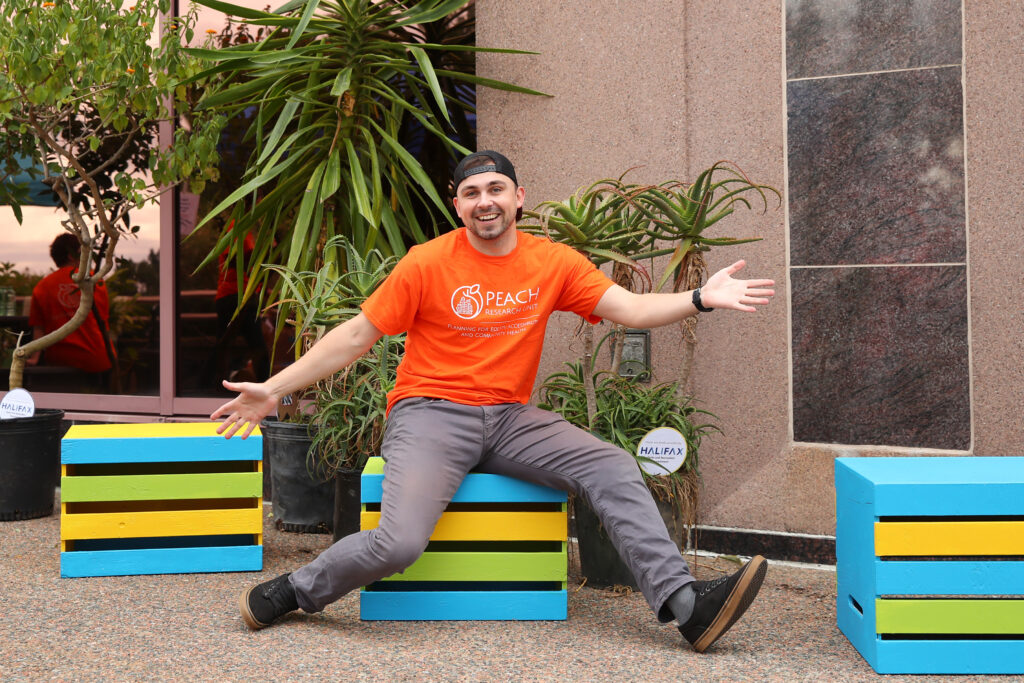
Hitting folks over the head with quick fixes for accessibility
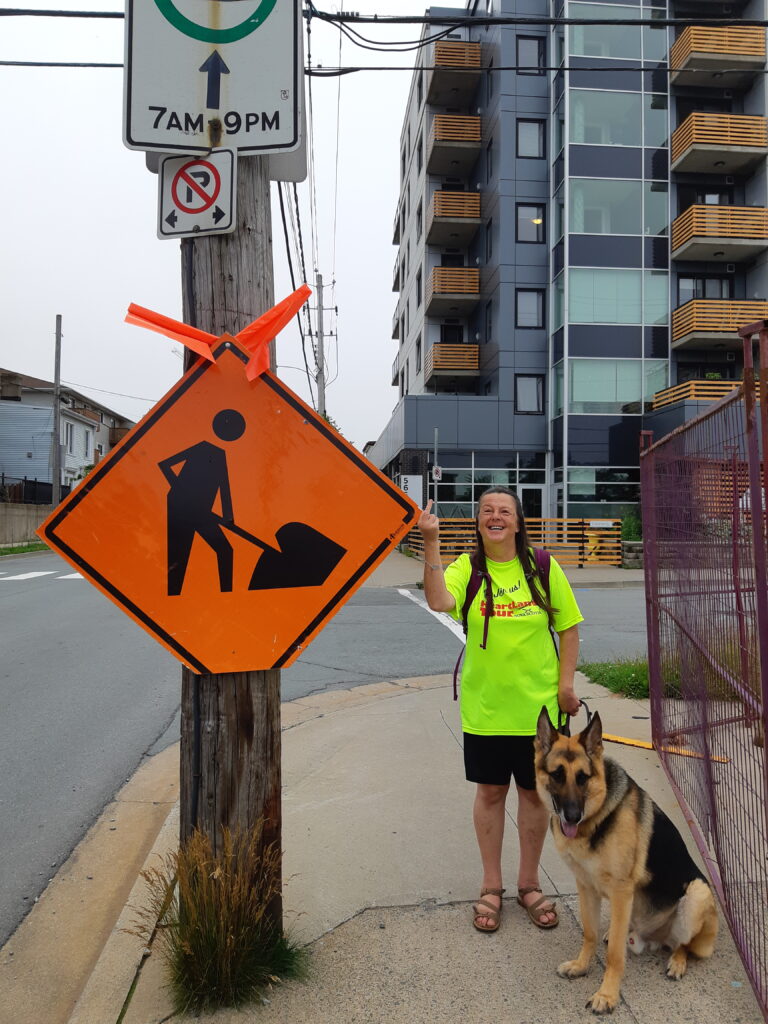
Our friend Milena Khazanavicius runs into things like this on the street. Every. Single. Day. These obstacles are impossible to avoid for persons who use canes or guide dogs because they do not detect obstacles way above the ground.
About 7% of Nova Scotians have some type of visual impairment, which adds up to be about 65,000 people. If that does not sound like a significant number, it may help to think that this number is roughly the same as the population of all elementary school children in Nova Scotia. If this many elementary school children were at risk of injuring themselves on the streets, policy makers would already be moving to eradicate these hazards at construction sites, wouldn’t they?
Whether you have vision challenges or not, people often get distracted while they are walking. For example, their eyes may be glued to their mobile phones while walking (true, they should not be doing that), or they may be talking with a friend and not paying attention, or they may have some big bags to carry. Spots like this are accidents waiting to happen for all pedestrians.
Design standards, regulations, policies are all important. But they are not enough. More importantly, something like this can be mitigated without regulations telling us, if we are all aware. It is a quick fix.
Construction companies and their staff with good awareness are already working hard to prevent these kinds of barriers. Let us all be aware and ask construction folks, planning folks, and politicians to be aware. Someday, any of us could be scraping our faces with the corner of a construction sign and flipping the finger at it—or worse, suffering serious injuries (and flipping the finger at the world).
Photovoice with Older Adults
In 2020, PEACH Research Unit’s Katie Vaughan partnered with Community Links Nova Scotia to engage with older adults living in Nova Scotia about the accessibility of public spaces in their communities. We are now excited to announce that this project will be extended into Phase Two as soon as May 2021!
This project is performed using a research method called photovoice, where participants take photos, and elaborate on their photos using their own words, to answer a research question. For this project, older adults are asked to take photos of public spaces that are either helpful or harmful to their ability to perform daily activities in the public spaces of their communities. In other words, this project asked to learn from older adults about the places they feel are accessible or inaccessible for their needs.
The photos and narratives provided by participating older adults during the pilot study have been very valuable for understanding aging-in-place design.
Katie has produced two videos to share the initial findings:
The Testimonial Video (appearing above) showcases some of the photos and comments that were collected from participants in first-person voice.
The Result Video presents key findings of the study, describing the priority design features for improvement from the perspective of older adults from the pilot study.
We are really proud of what has been accomplished so far, and are excited to begin the extension of the project. It is our goal to learn more about accessible and inaccessible public space design in not only urban but also rural communities. If you are 65 years of age or older, live in Nova Scotia, and are interested in contributing to this project, please email Katie at kvaughan@dal.ca.
HRM Audible Crossings
Pedestrian safety is a key component of inclusive, sustainable communities. The mobility of persons between destinations and within their communities is largely impacted by the quality and composition of sidewalks, street crossings, lighting, and other street infrastructure. For persons with physical, sensory, or cognitive impairments, remaining safe as a pedestrian can be particularly challenging if appropriate safety measures are not in place.
Pedestrian crossings are high-traffic and, therefore, high-risk areas for pedestrians. In the Halifax Regional Municipality (HRM), the majority of collisions involving pedestrians occur at intersections with traffic signals 1. Currently, Transportation Association of Canada’s (TAC) guidelines recommend the use of audible, visual, and vibrotactile pedestrian signals at controlled intersections to alert pedestrians when crossing is possible 2.
Halifax Regional Municipality (HRM) has audible crossing signals installed at 84 intersections, which accounts for only 0.58% of all intersections in HRM. Some of these audible signals automatically sound to indicate when crossing is permitted (16 of 84, such as at the corner of Spring Garden Rd. and Queen St.) but the majority are button-activated by users (68 of 84). The button-activated signals utilize ‘beacon actuation’ which requires the user to press and hold the pushbutton for at least 3 seconds to activate the audible signal 3.
In the summer of 2020, a group of local accessibility advocates performed an audit of HRM’s audible crossings to assess which button-activated signals are operating as programmed and which are not. This audit found at least half of the audible signals were operational at most intersections. However, only four intersections had working audible signals for all directions of travel.
The map below illustrates the findings from this audit. The square brackets next to each intersection name indicates the number of working audible signals against the total number of legal pedestrian crossings at an intersection.
The scarcity of audible signals at crossings in HRM is concerning as they provide a key navigational cue to numerous individuals living with sensory or cognitive impairment. Without these signals, many persons will either be putting themselves at risk when crossing traffic, or they will stay home, becoming more isolated from feeling unable to travel independently. HRM has demonstrated plans to increase the number of crossings with audible signals through its Active Transportation Priorities Plan, which includes the intention to install accessible signals at 4-5 intersections per year 4.
To help illustrate the importance of these devices, members of the PEACH Research team participated in a sight-loss simulation activity led by Milena Khazanavicius, an advocate for blind and partially sighted residents of HRM. We each took turns crossing a signaled intersection blindfolded, using only a white cane and the audible crossing signal to navigate. While the experience of someone who lives with sight-loss will certainly differ from what we could experience in one afternoon, we all felt the aid of an audible signal to confirm when it was our turn to cross as pedestrians, and to assist as a directional cue to follow to the opposite corner, was hugely beneficial to an otherwise daunting experience for us.
Ensuring that more signals are installed, and that the signals are operational for users, is crucial for enabling equitable travel for numerous individuals. This audit brings to attention that we must take maintenance of these features seriously as they have a significant impact on the daily lives of community members. We must also continue to consult with persons who experience sight loss, and those with other disabilities who have daily expertise on the existing barriers to safe pedestrian travel.
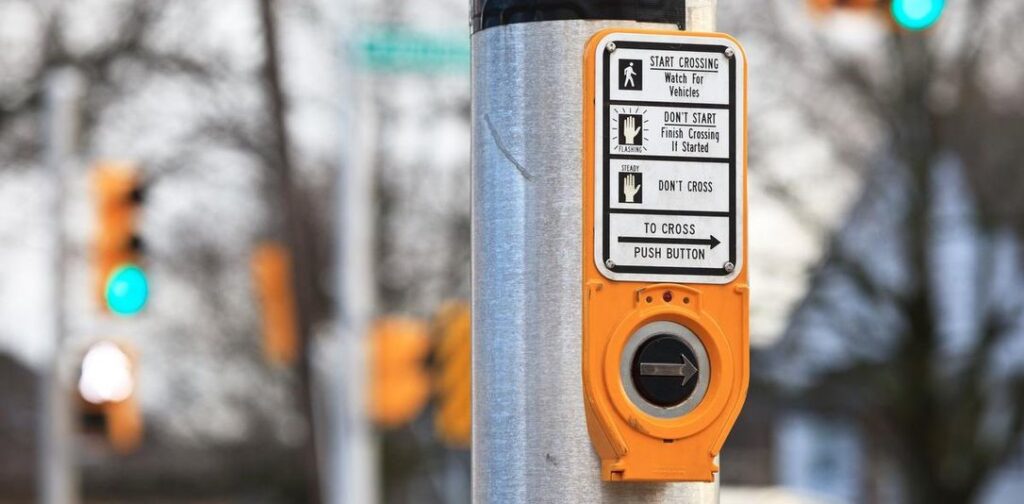
We would like to sincerely thank Milena Khazanavicius and all persons who performed the audit of audible signals in downtown Halifax for sharing these findings with us.
1.Halifax Regional Municipality. (2017, March 23). Pedestrian Safety Semi-Annual Reporting, Transportation Standing Committee. https://www.halifax.ca/sites/default/files/documents/city-hall/standing-committees/170323tsci2.pdf
2.IBI Group. (2007). The New TAC Accessible Pedestrian Signals Guidelines. Annual Conference of the Transportation Association of Canada. http://conf.tac-atc.ca/english/resourcecentre/readingroom/conference/conf2007/docs/s10/loane.pdf
3.Halifax Regional Municipality. (2020). Traffic Information for Hearing Visual Impaired. https://www.halifax.ca/transportation/streets-sidewalks/traffic-information-individuals-vision-or-hearing-impairments
4. Halifax Regional Municipality. Active Transportation. https://www.halifax.ca/transportation/transportation-projects/active-transporation
Access to parks during the COVID-19 crisis
When Nova Scotia declared a state of emergency of March 22nd, 2020, all parks, trails, and beaches in the province closed. These were early days, when cases were low in the province, and it was yet unknown how the COVID-19 virus would impact Nova Scotia. As the days went on, Stephen McNeil, Nova Scotia’s premier, feared that Nova Scotians were not taking the pandemic seriously. During a press briefing, the premier sternly advised Nova Scotians to “stay the blazes home”. People who disobeyed and ventured onto trails and into parks were fined. To ensure compliance, parks, trails, and beaches were wrapped in caution tape and surrounded by park closure signs. This signaled that parks were dangerous; a place where someone may contract COVID-19.
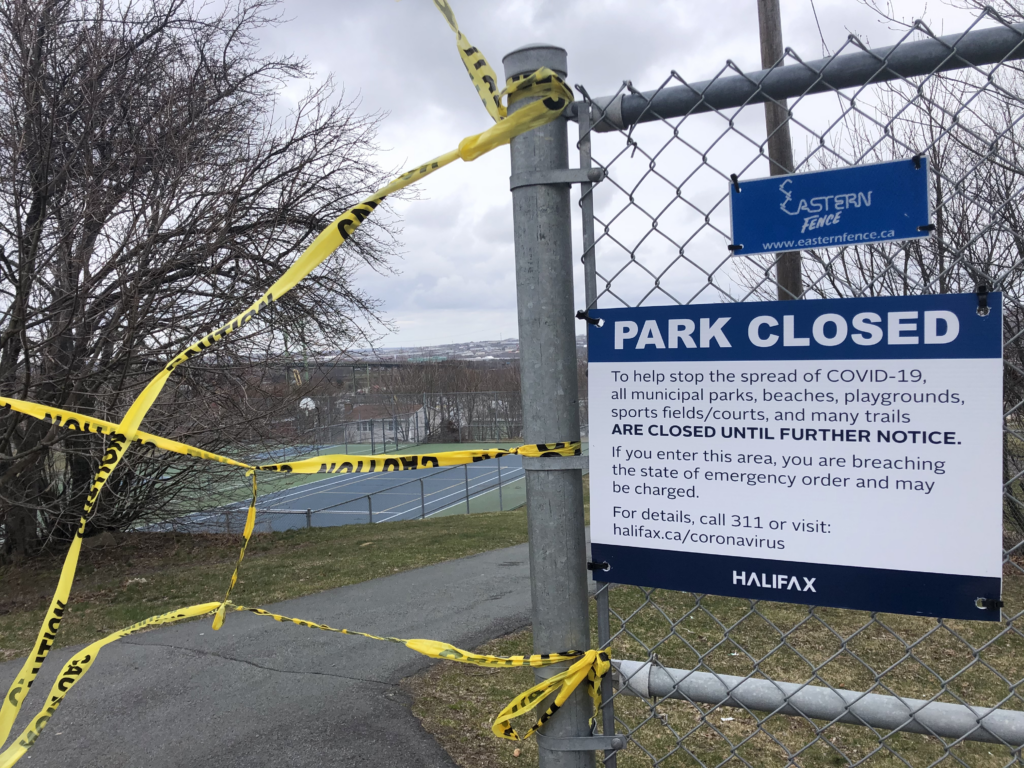
Parks are an essential public space for gathering, self-reflection, and physical activity; the mere act of being in nature promotes feelings of peace and serenity. In fact, there is a significant body of scientific literature outlining the health and well-being benefits of spending time in nature, particularly during periods of stress and disruption [2–5]. Research on the biophilia hypothesis reveals that humans have an innate tendency to connect with nature and by doing so experience mental and physical health benefits.
Why, then, were parks closed during this period of crisis? Surely it was possible to maintain access to parks in a way that aligns with public health guidelines…?
In order to understand how jurisdictions across Canada addressed the issue of park access, our research examined the actions taken by 17 major urban municipalities. Out of the 17, only six closed municipal parks to the public.
It turned out Halifax was an anomaly in its approach to park access during the COVID-19 crisis. Instead of seeing parks as a vector for COVID-19 transmission, most Canadian municipalities took action to maintain park access in a way that aligns with public health guidelines. On the other hand, all municipal parks, including pathways, public facilities, and playgrounds were closed in Halifax.
The map below shows the actions taken by municipalities to facilitate access to nature during the COVID-19 crisis and where in Canada parks were closed. Specifically, some municipalities simply closed “high-touch” zones, such as playgrounds, washrooms, and picnic tables, whereas other municipalities took a more active approach, deploying park staff, developing educational campaigns, and closing roadways in and adjacent to parks to create more room for park users.
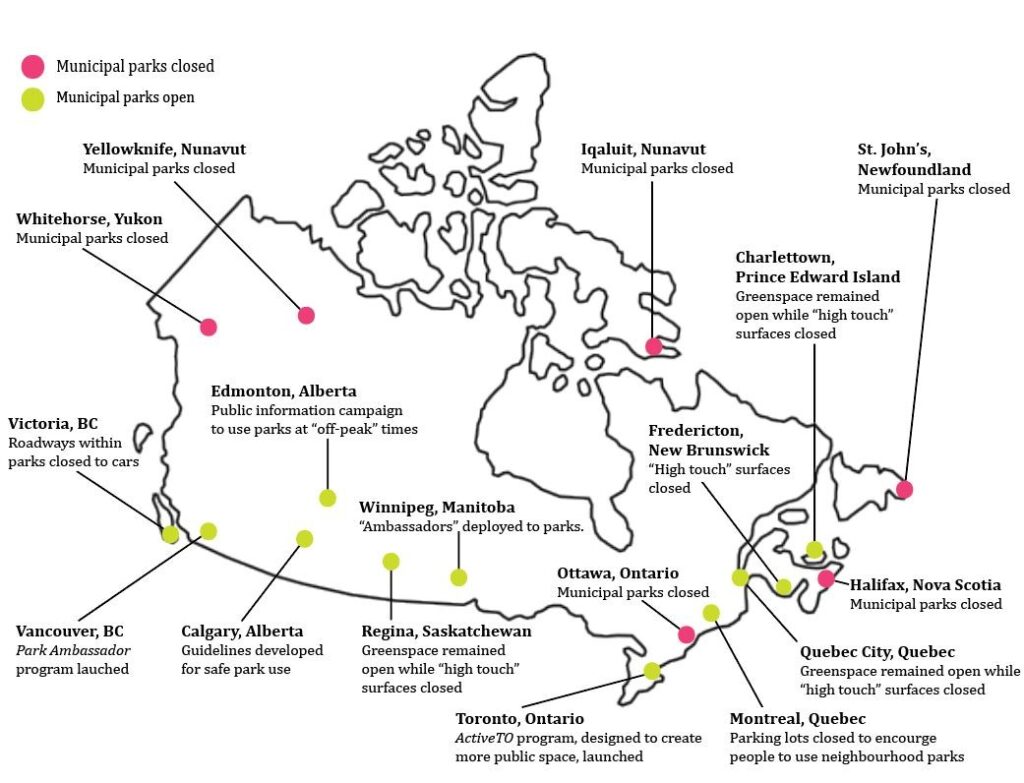
Maintaining access to parks is an important component of any public health strategy for maintaining mental and physical health over the long-term and should be included in COVID-19 response policies. In fact, many government leaders touted the mental and physical health benefits of spending time in nature. For example, the manager of the Vancouver Park Board stated:
“We recognize the important role that our outdoor spaces play in people’s overall health and wellness, particularly mental health at this very stressful time”
– Manager, Vancouver Park Board (April 4th, 2020)
Furthermore, British Colombia Provincial Health Officer said:
“I do believe, and I’ve said this repeatedly, how important it is for us to have access to outdoor areas, particularly in urban areas where people being cooped up inside can lead to a lot of other anxiety and challenges and problems, including mental health problems”
– Dr. Bonnie Henry (April 22nd, 2020)
Finally, despite a six-week park closure, Nova Scotia’s premier also commented on the health and well-being benefits of park access. When announcing the opening of provincial and municipal parks on May 1st, 2020, Nova Scotia’s premier stated:
“Get out, get fresh air, do a little physical activity and hang [out] with your family. It’s the best medicine right now”
– Stephen McNeil (May 1st, 2020)
The way in which government officials framed the issue of park access, that is, as a way to support mental and physical health throughout the pandemic, makes a case for maintaining access to parks during crisis.
There is a growing body of research that suggests the risk of contracting COVID-19 in an outdoor environment is low [8]. This fact suggests that it is possible to maintain access to parks throughout the COVID-19 crisis, particularly if extra safety precautions are put in place. For example, many municipalities closed “high-touch” zones within parks. This included playgrounds, picnic areas, and washrooms. Another common strategy was to deploy municipal staff to disseminate information about the importance of physical distancing. Instead of taking an enforcement approach through increased policing and ticketing, which arguably creates more stress and division within a community, education promotes safe behavior within parks. Finally, closing roadways within or adjacent to parks was another common strategy intended to facilitate safe park use. Toronto’s ActiveTO program, for example, identified opportunities to expand public space by closing roadways thereby promoting physical activity and facilitating access to nature, even within a dense urban environment.
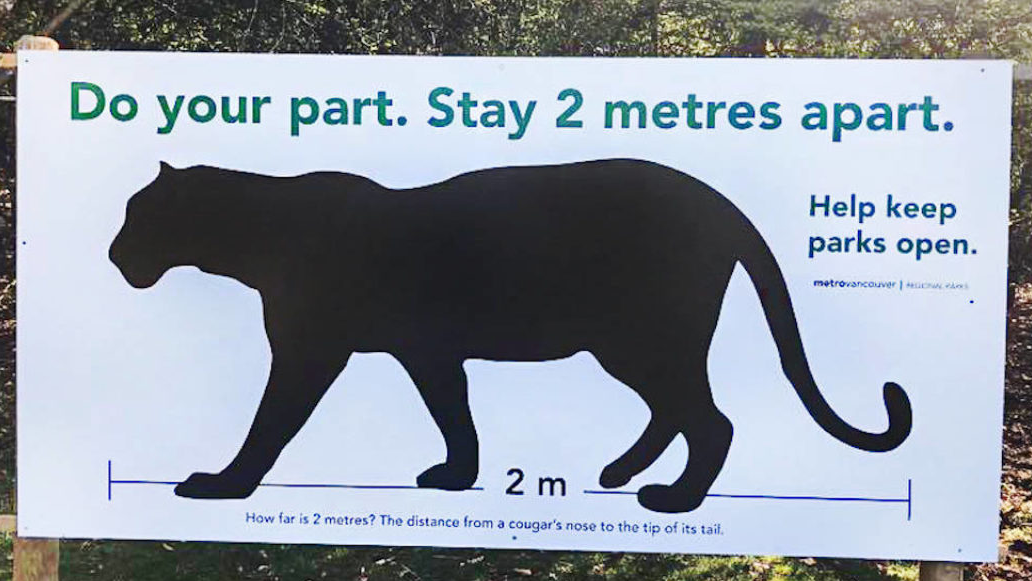
The health and well-being benefits of facilitating access to greenspace, particularly through periods of crisis, is supported by the concept of urgent biophilia, which posits that during periods of crisis, the desire to connect with nature is heightened. In fact, there are many examples of people seeking out contact with nature during crisis, including in the aftermath of Hurricane Katrina, in refugee camps, and following the 9/11 attacks on the World Trade Centre [5]. In each of these examples, connecting with nature aided the affected community’s recovery efforts by supporting mental and physical health. COVID-19 will likely be no different. By developing strategies aimed at facilitating access to nature during crisis, the capacity for both individuals and communities to navigate social and economic challenges will be strengthened.
While COVID-19 is a pressing public health emergency, other components of health, such as mental health and physical fitness, must not be ignored. In order to promote health over the long-term, opportunities for individuals to safely connect with one another, exercise, and enjoy the natural world should be prioritized. COVID-19 will likely be with us for the foreseeable future. By ignoring these components of health, we risk unleashing a slew of secondary health challenges, such as depression, addiction, and anxiety. By taking proactive steps to facilitate access to nature during a disaster, populations will ultimately be better prepared to navigate the social and economic challenges of the crisis and will experience more overall positive health outcomes.
The results presented in this article are a part of the research project: Access to parks during the COVID-19 crisis: Building resilience through urgent biophilia.
Please contact sashamosky@dal.ca for more information.
1. Groff, M. Parks, trails and driving ranges reopen as province eases some restrictions (update) – HalifaxToday.ca Available online: https://www.halifaxtoday.ca/coronavirus-covid-19-local-news/parks-trails-and-driving-ranges-reopen-as-province-eases-some-restrictions-2316867 (accessed on Jul 15, 2020).
2. Berman, M.G.; Kross, E.; Krpan, K.M.; Askren, M.K.; Burson, A.; Deldin, P.J.; Kaplan, S.; Sherdell, L.; Gotlib, I.H.; Jonides, J. Interacting with nature improves cognition and affect for individuals with depression. J. Affect. Disord. 2012, 140, 300–305, doi:10.1016/j.jad.2012.03.012.
3. Tyrväinen, L.; Ojala, A.; Korpela, K.; Lanki, T.; Tsunetsugu, Y.; Kagawa, T. The influence of urban green environments on stress relief measures: A field experiment. J. Environ. Psychol. 2014, 38, 1–9, doi:10.1016/j.jenvp.2013.12.005.
4. Kellert, S.R.; Calabrese, E.F. The Practice of Biophilic Design; 2015;
5. Tidball, K.G.; Krasny, M.E. Greening in the Red Zone Disaster, Resilience and Community Greening; Springer, 2014;
6. Samuelsson, K.; Barthel, S.; Colding, J.; Macassa, G.; Giusti, M. Urban nature as a source of resilience during social distancing amidst the coronavirus pandemic. 2020.
7. Tidball, K.G. Urgent biophilia: Human-nature interactions and biological attractions in disaster resilience. Ecol. Soc. 2012, 17, doi:10.5751/ES-04596-170205.
8. Mackinnon, B.-J. Higgs says municipal parks can stay open if physical distancing enforced | CBC News Available online: https://www.cbc.ca/news/canada/new-brunswick/covid-19-municipal-parks-higgs-new-brunswick-1.5518558 (accessed on Jun 9, 2020).
9. Grochowshi, S. Stick to your local parks this Easter weekend, says Metro Vancouver – Maple Ridge News Available online: https://www.mapleridgenews.com/news/stick-to-your-local-parks-this-easter-weekend-says-metro-vancouver/ (accessed on Jul 24, 2020).
My training in Women’s Safety Audits
On a weekend in late January, myself and two other PEACH team members attended a workshop to become trainers for Women’s Safety Audits (WSA). These safety audits were created through the UN Women’s Global Initiative, “Safe Cities and Safe Public Spaces”, with the goal being to combat violence against women and girls around the world.
WSAs are performed by women to assess how their needs and interests are or are not being met by the built environment. The results of a completed audit can help to guide the design and planning of public spaces, while the process of completing an audit can empower and educate women (and others) about safety and social barriers in public space.
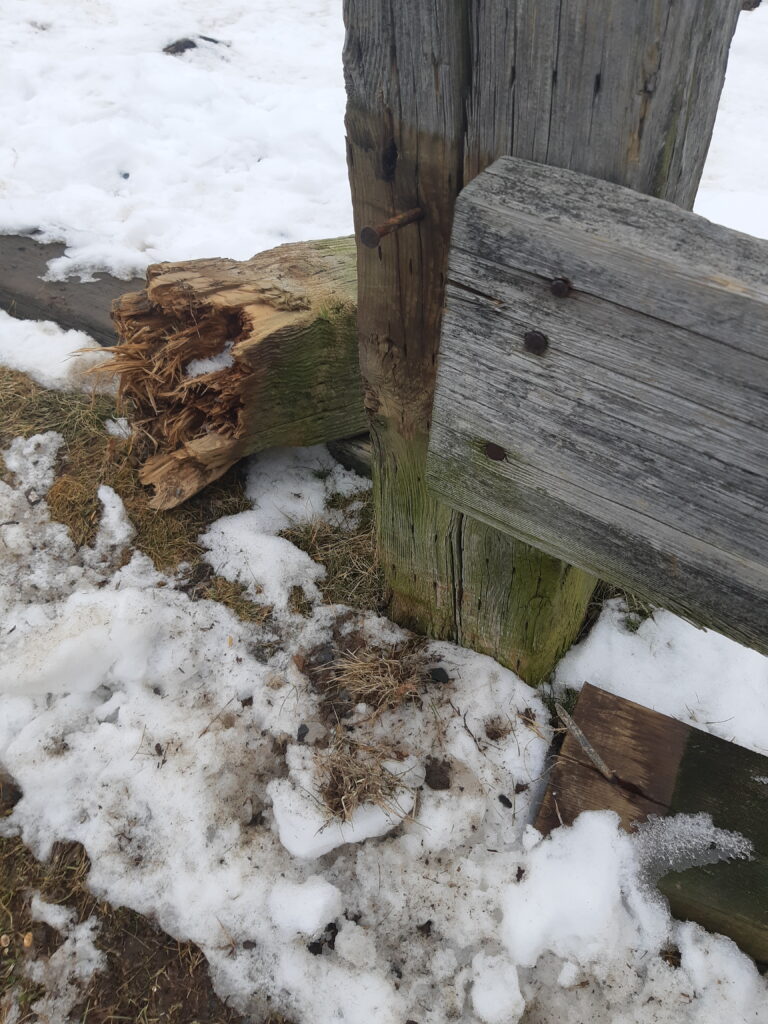
Image of a railing in need of repair along a walkway in a public park. Exposed nails and unstable wooden beams pose a safety risk to pedestrians, particularly small children. This was identified by women participating in a trial Women’s Safety Audit during the training.
On the first day of the workshop, we placed green, yellow, and red stickers on a map to indicate where we feel safe and welcome (green), unwelcome (yellow), and unsafe (red) on the peninsula of HRM. This activity sparked conversations between participants about why places felt safe or unsafe. Sharing our experiences of these places was eye-opening, especially when hearing first-hand how age, race, and other social factors contribute to the varied experiences of women in urban spaces. WSAs recognize that women have unique expertise on public spaces and safety from their daily lives, and these experiences inform the audit process. My biggest takeaway from the weekend was, if a public space doesn’t feel safe for everyone, it isn’t safe for everyone.
Historically, many decisions in urban planning have failed to consider the needs and interests of the diverse users of public space. Thanks to this workshop, I am one of many women who have learned about the value of sharing our daily lived experiences to inform and shape our communities. Going forward, I hope to build off this momentum and educate future colleagues and peers about the value of WSAs and the contributions of women’s daily lived experiences.
Reflections on Wayfinding and Accessibility in Downtown Halifax
This fall, I chose to look at wayfinding systems in downtown Halifax as part of my coursework at Dalhousie’s School of Planning. Wayfinding systems are put in place to make cities easier to navigate for people of all ages and abilities. My project started looking at how a wayfinding system could enhance the tourist experience in downtown Halifax. However, a wayfinding system would benefit both tourists and locals alike, making the built environment more accessible for everyone.
Unlike many cities of a similar size, Halifax does not have a wayfinding strategic plan. This means that there is little to no informational signage directing people to destinations and facilities around the downtown. Moreover, the signage that currently exists is primarily located around the waterfront, targeted at tourists rather than residents, and has limited function for accessibility.
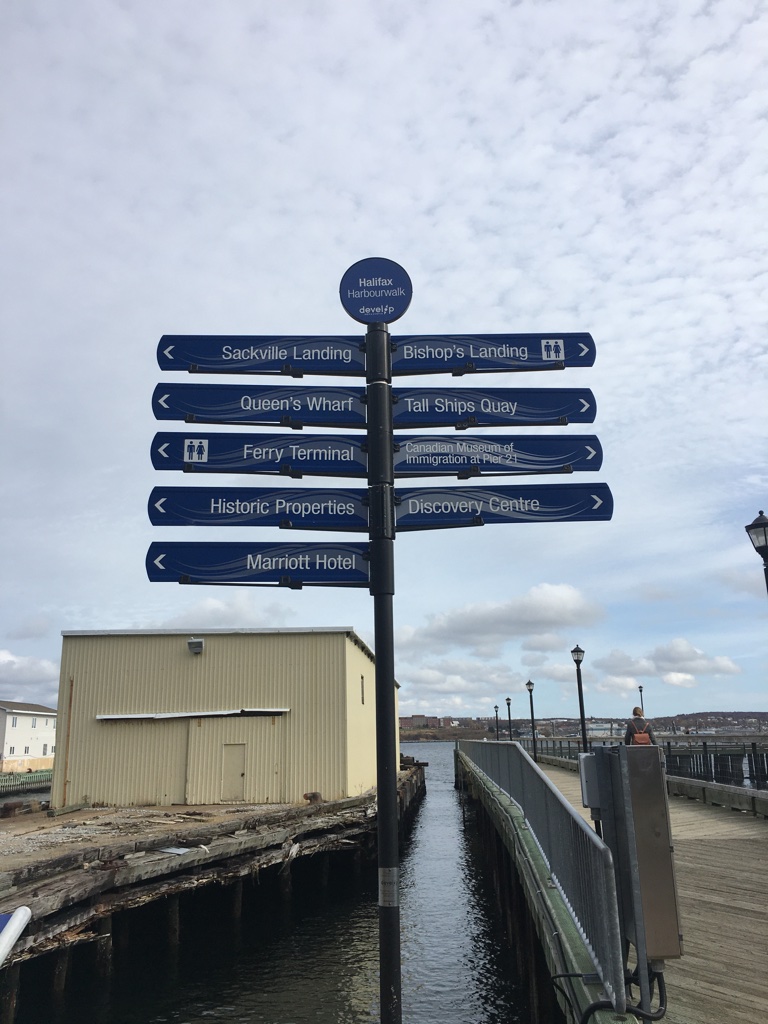
A current example of a wayfinding sign in downtown Halifax. This sign shows North-South directions, directing people towards tourist destinations along the waterfront. This sign does not reflect any element of accessibility.
My research found that there is great potential for the implementation of a wayfinding system in Halifax. Wayfinding in Halifax could encompass a combination of physical signage, sidewalk design, or any other audio-visual cue that could help an individual navigate the built environment. While municipal plans such as the Active Transportation Priorities Plan and the Land Use By-law and Transportation and Streetscape Design Functional Plan outline the need for a wayfinding strategy, there is currently no other publicly available document to explicitly address wayfinding in downtown Halifax.
While I was looking into wayfinding, I attended a lecture by Andrew Taylor, an accessibility advocate who spoke about his experience of Halifax’s downtown from his perspective as a person with a physical disability. Andrew shared some of the challenges he faced when navigating due to lack of signage and information relevant to his accessibility needs. For example, because there is no information suggesting to users which streets and/or areas of the city have accessibility features or facilities, Andrew said he had to be very particular about which routes he traveled and where he chose to go. Andrew added that he often felt like he could only travel on streets he was already familiar with. A universally accessible wayfinding system could direct users to accessible washrooms, building entrances, ramps, and/or routes that have been designed for accessibility in order to address this concern and enhance the experience of individuals living with a disability.
Andrew’s talk made me reconsider what is meant by a good wayfinding system. While traditional wayfinding systems have an explicit focus on informational signage, there are a variety of ways that directional information can be integrated into the built environment. Design interventions in the built environment, such as auditory signals at an intersection, ultimately create a safer urban environment for everyone. Another example of how this could be done is by implementing visual cues that alert individuals of an upcoming curb. This would in turn make more areas of the city accessible to residents living with a disability.
Halifax is a great candidate for a wayfinding system to assist tourist and locals of all abilities to effectively navigate and experience the community. If Halifax were to implement a wayfinding system, applying an accessibility lens to the design is crucial. Designing a wayfinding system through an accessibility lens means understanding how people with disabilities move through the city. This must be done through careful consultation and documentation of the lived experience of those in the disability community. Capturing how people with disabilities experience downtown Halifax is a critical first step in building a wayfinding system that benefits all people.
Another great lecture!
Last week, we were pleased to welcome Jen Powley as part of the First-Person Narratives for an Accessible Built Environment lecture series. Jen spoke about accessibility considerations from her experience as a person with progressive multiple sclerosis, an advocate for persons with disabilities, and as a certified planner — a graduate of our own School of Planning!
Firstly, Jen used many examples of spaces that have made her feel like an afterthought. She described for us how wheelchair users are often excluded from everyday activities and events. In addition, Jen was able to speak to barriers experienced by persons who are visually impaired.
One of the biggest challenges to planning for accessibility is trying to come up with solutions that work for everyone. Jen highlighted how some design solutions, meant to address the needs of persons with certain disabilities, can be in direct conflict with the needs of others. However, Jen’s lecture was optimistic. She discussed how she herself is continuing to advocate for more accessible communities through a pilot project on housing for those with severe disabilities. She also encouraged students in the audience to continue to seek solutions to the challenges of designing for all.
In conclusion, PEACH would like to thank Jen for her participation in this lecture series. We are grateful for her expertise and passion for planning for accessibility. We hope to continue to work with her on current and future projects.
Jen is the author of Just Jen: Thriving Through Multiple Sclerosis. Jen graciously signed a couple copies for the PEACH Research Unit. We recommend checking it out!
Launch of Lecture Series
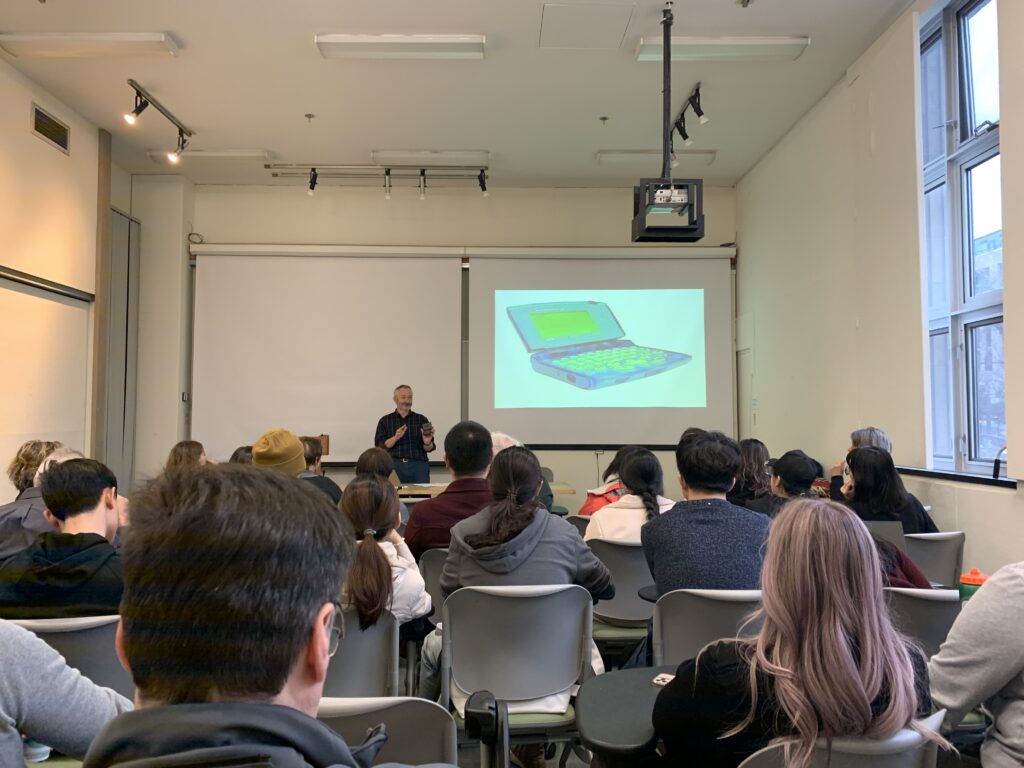
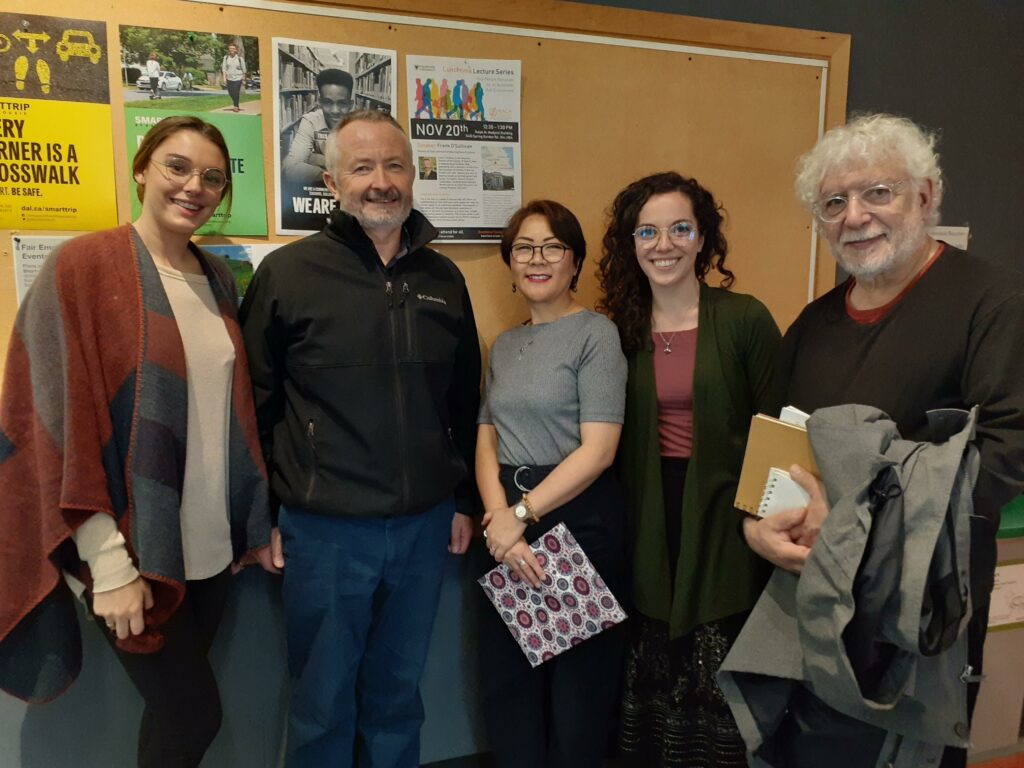
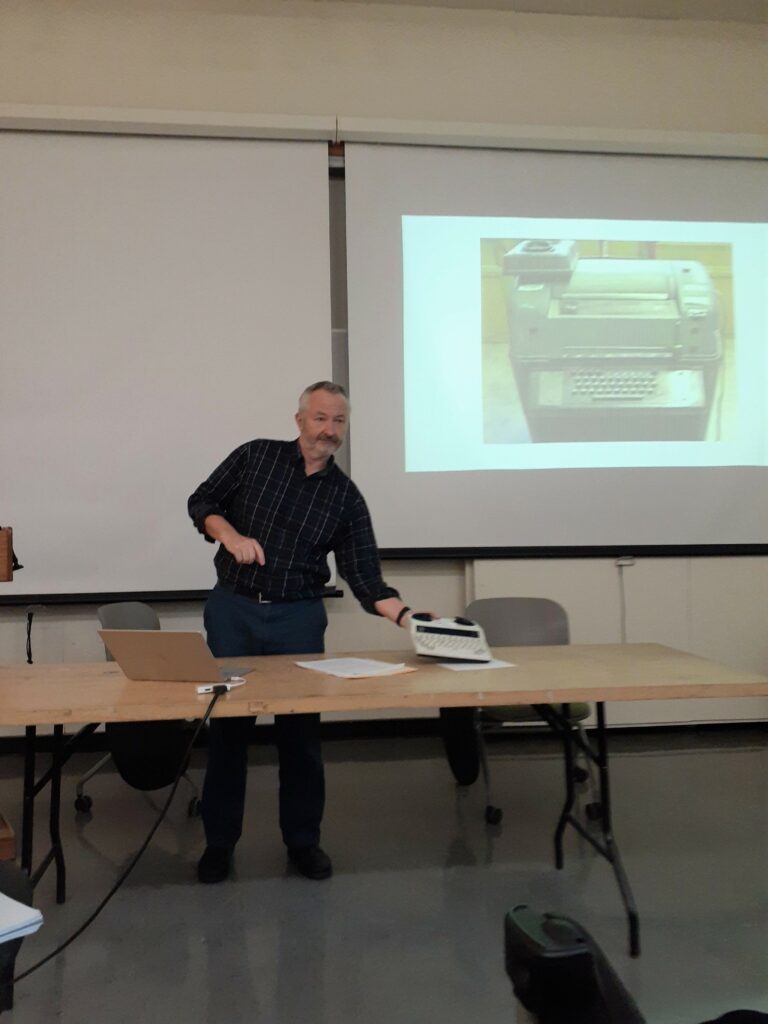
Yesterday, PEACH hosted the first lecture of the First-Person Narratives for an Accessible Built Environment lunchtime lecture series. We were happy to see a large turn out, with many interested community members in attendance.
Frank O’Sullivan, Executive Director of the Society of Deaf and Hard of Hearing Nova Scotians, offered valuable insights about some barriers to communication that deaf persons often experience in public spaces. His experience emphasized the importance of visual ques and textual or graphic instruction for wayfinding, navigation, and emergency systems. Frank explained how modern technologies, in the form of personal cellphones, CART translation services, and internet apps, have contributed significantly to eliminating social barriers for persons of the deaf community.
DeafSpace is a relatively new concept in inclusive design, where spaces are shaped by and for members of the deaf community as opposed to hearing persons. Orientation of seating, brightness of lighting and colour contrasting, sightlines for movement, and acoustics are some considerations for the design of spaces inclusive of deaf and hard of hearing persons. Gallaudet University in Washington, DC is leading this practice of DeafSpace in the development of its campus’s indoor and outdoor spaces. We invite you to learn more about DeafSpace at Gallaudet University at https://www.gallaudet.edu/campus-design-and-planning/deafspace.
PEACH would like to thank Frank for his participation in this lecture series. We look forward to working with him and members of the deaf and hard of hearing community of Halifax more throughout our research. Thank you also to everyone who made it out to attend this first lecture. We hope you will join us again when we host our next speaker!
